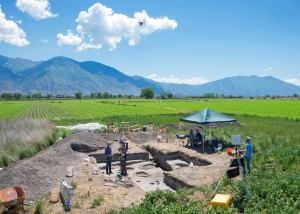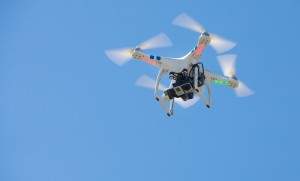A group of students and employees at BYU implemented new technology to enhance research in a recent discovery of Indian ruins fifteen minutes away from the BYU campus.
BYU anthropology professor Michael Searcy has been analyzing an excavation site of the Fremont Indians using technology such as flying drones and new software programs that store data at a much faster rate than writing everything down manually. Searcy said that research has been greatly enhanced with the new technological advancements.
“I never thought that I would see myself do this,” Searcy said. “It’s so new and so innovative.”
During the past two years, Searcy and research assistant Scott Ure have been working on the excavation site that is located on the Hinckley base near Utah Lake and the Provo River.
During the summer of 2015, Searcy, Ure and several BYU students were able to work with different kinds of tools so they could enhance their research. One of the most useful tools was a flying drone, which searcy called a Phantom Drone.
The drone flies over the site and scans the excavation site using aerial coverage with video and photos, giving more information about the structure and landscape of the former pit house.
Daniel King, one of the graduate students that worked with the drones personally, said he was able to see the benefits of using a drone for his research.
Ure also worked on the excavation site in Fremont. He added that the aerial imagery from the drones gives a better vantage point, rather than using a ladder or an actual plane. One of the other significant things that enhances their research is the way data is collected and documented.
An app called Excavator makes it easy to collect data and transfer the data from a tablet or iPad to a server that stores all the data collected from each researcher. When the data is stored, it is accessible to everyone, making it easier for the team to analyze and conclude its findings.
Ure added that the new app allows them to search exactly what they need.
“Remote Wi-Fi helps transfer data from our tablets to our servers which improves speed and data collection,” Ure said.
Ure and Searcy have continued to find different tools to improve their research in the past 10 years.
“Every year brings new advances in technology,” Searcy said.
Currently they are developing a way to scan historical sites using thermal imaging on the drones. Doing so will allow any researcher to create a 3D surface using the drones.
When asked about the significance of his research on this particular Indian site, Searcy specified how close it is to BYU campus. In the span of 15 minutes, any BYU student can drive and see the Fremont Indian Site.
Professor Searcy gave an excited response to all the new technology.
“The development of new drone technology is giving archaeologists and anthropologists new ways to study the earth’s history,” Searcy said.
– See more at: http://universe.byu.edu/2015/09/08/new-technology-makes-archaeological-discoveries-easier/#sthash.Z2K7DvD7.dpuf

